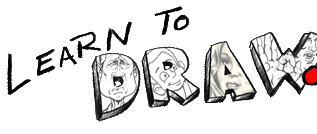 |
|
Click to see the differences of each
side of the face. |
Seeing the face at some degree of a three quarter
view is probably the most common way we see the face, so
it'll be the most common way the face would be drawn.
Three quarters is when the subject is turning the head
slightly so that they're not looking straight at you.
You only see three quarters (more or les) of the face,
hence the name. The side of the face that's closest to
you looks pretty normal, but the far side of the face
looks a little squashed. The reason the face gets skewed
is because the face is being foreshortened. Because the
face looks squashed, you won't be able to do the same
types of measurements on that side of the face that you
did on the near side.
 There
may be
less than one eye between the eyes. There
may be
less than one eye between the eyes.
 The
far eye may be opened to a different degree than the
near one, thus the shape of the far eye could be a lot
different than the near one. The
far eye may be opened to a different degree than the
near one, thus the shape of the far eye could be a lot
different than the near one.
 The
far nose lobe looks smaller than the near one, if you
see the far nose lobe at all. The
far nose lobe looks smaller than the near one, if you
see the far nose lobe at all.
 The
far side of the mouth will look different than the near
side. The
far side of the mouth will look different than the near
side.
 You'll
be able to see the near ear and may not be able to see
the far ear at all. You'll
be able to see the near ear and may not be able to see
the far ear at all.
 The
contour of the face on either side will be very
different because the cheek bone could be more visible
on the far side. The
contour of the face on either side will be very
different because the cheek bone could be more visible
on the far side.
You will still be able to measure using the eye as the
standard, but you'll measure things like how much less
of one eye there is between the eyes, and how many eyes
the cheekbone sticks out past the nose. For the near
side of the face, you can still do measurements like the
nose is the same height as the length of an eye. But the
distance from the eye to the ear may no longer be the
same as the distance from the eye to the chin like in a
profile. Keep measuring features on the face against one
another and you're three quarter portrait will look
fine.
|
